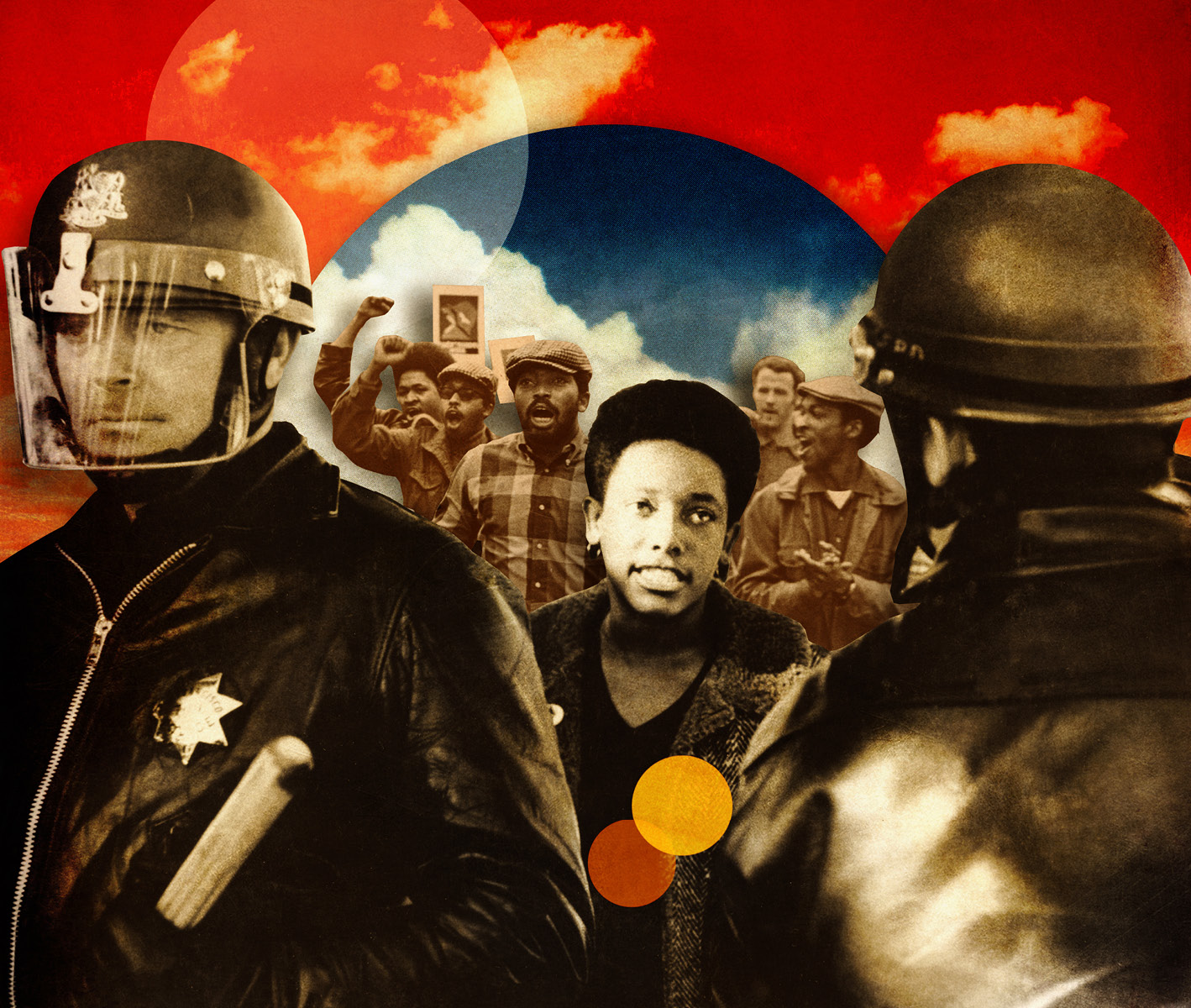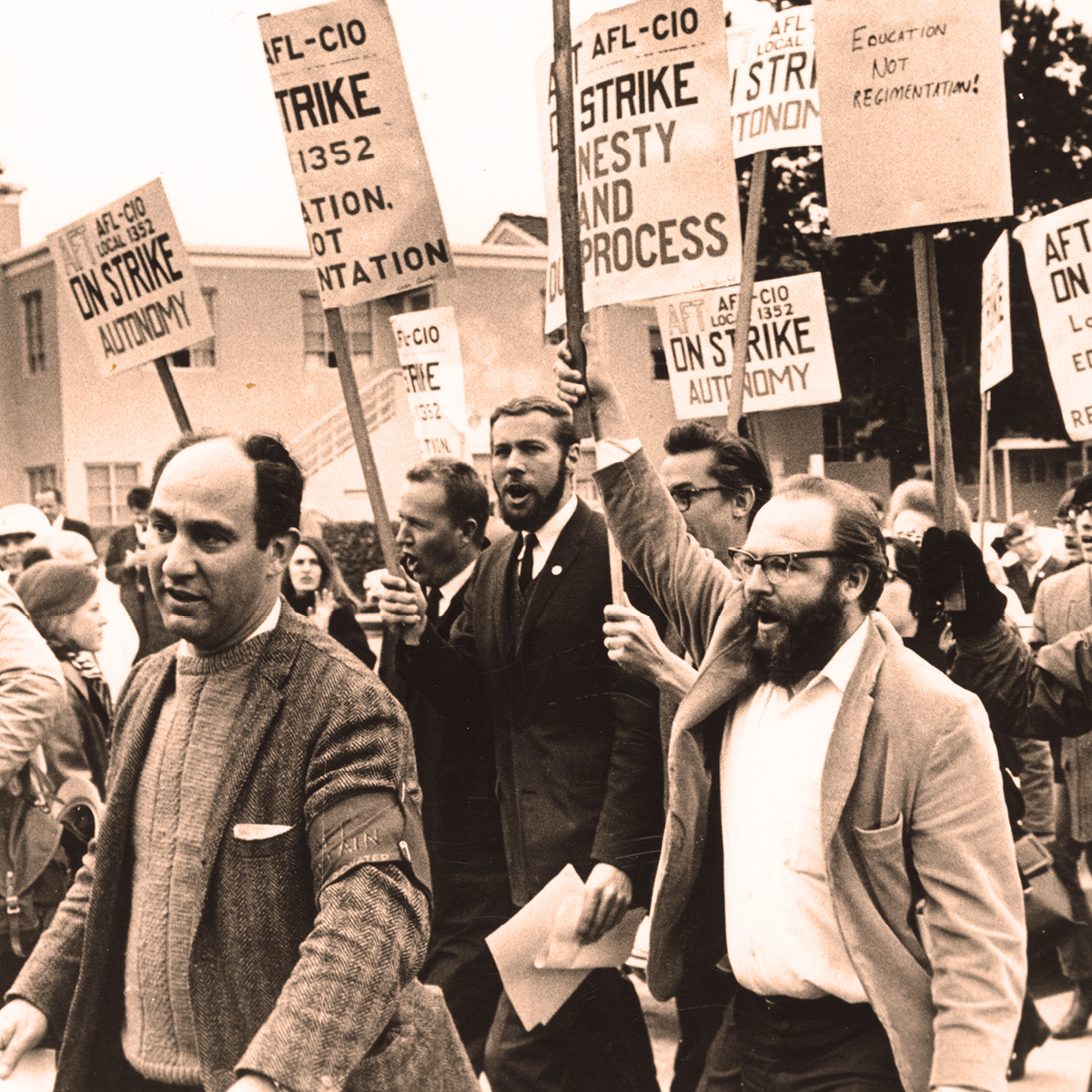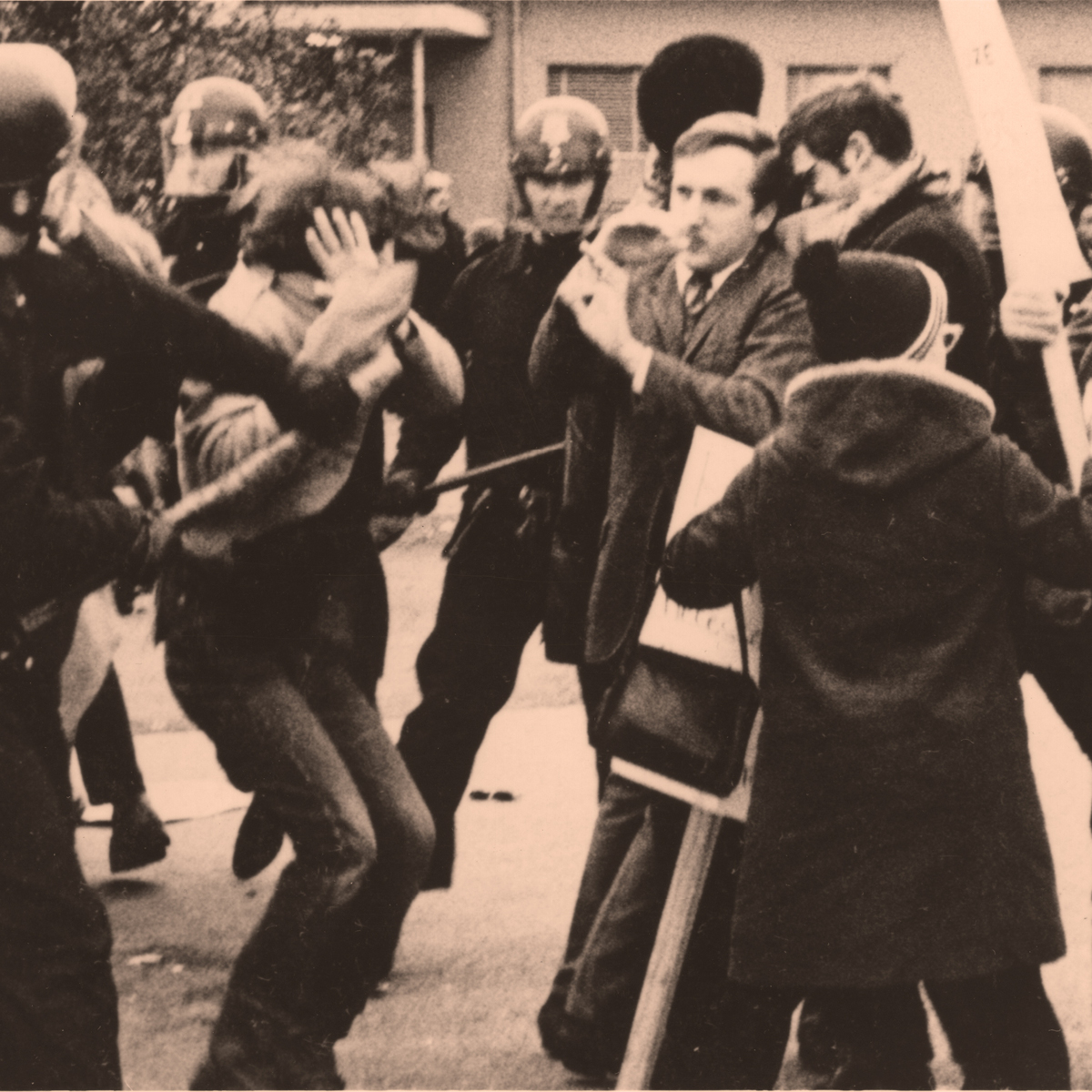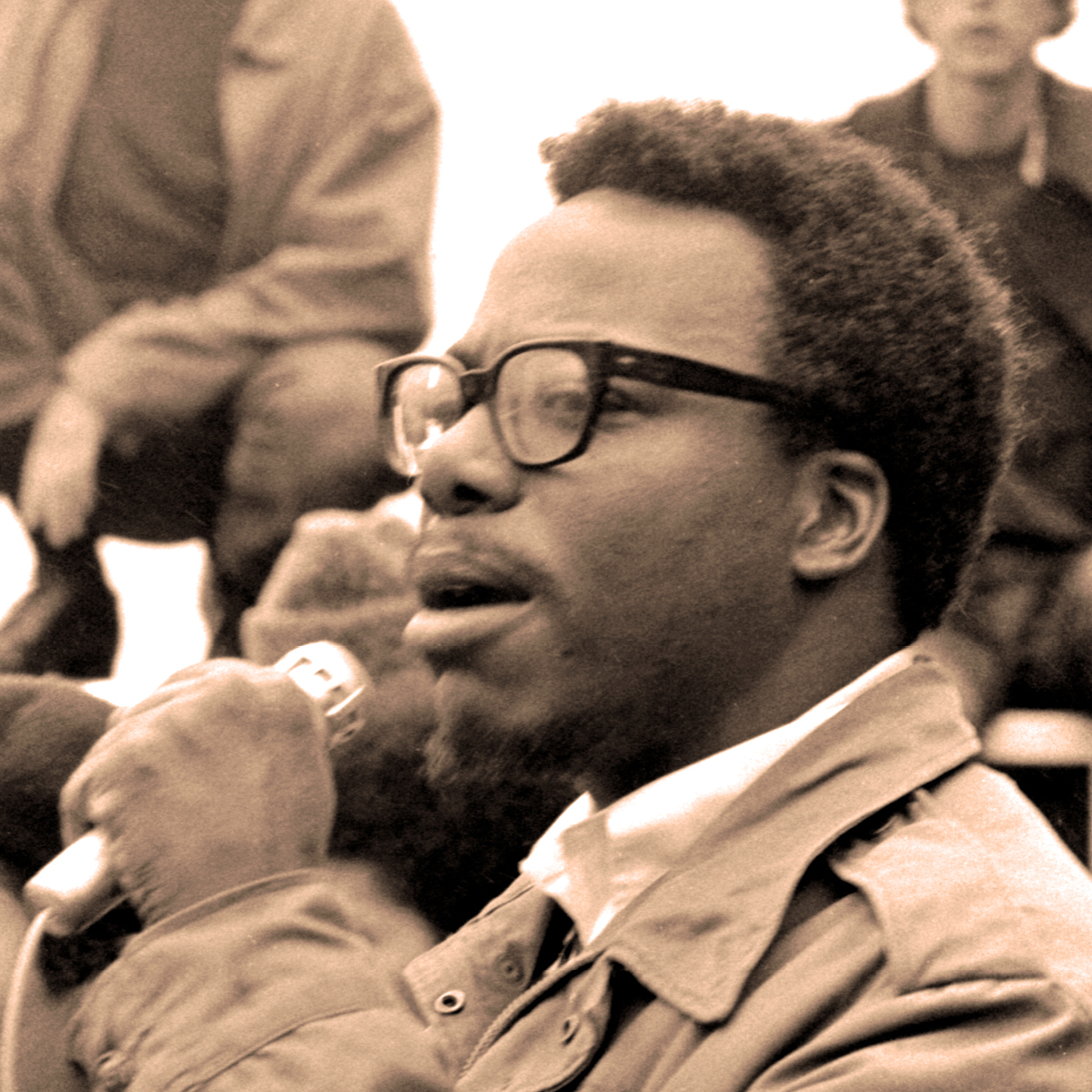
Illustration by Peter Horvath/Photos by AFT, Local 1352 collection and Terry Schmidt
You Say You Want Revolution
By Yumi Wilson
In 1968, a student-led strike swept across campus and changed the University forever
Crowds of angry protesters. Policemen in riot gear. Stroll across the San Francisco State University campus on a typical autumn day in 2018, and you’ll see exactly what you’d expect: students from every background hurrying to class, discussing their studies (and politics and books and music), eating, playing Frisbee, zipping by on skateboards (though it’s against the rules) and just soaking up the sun on the Quad. But if you were on campus 50 years ago, in the fall of 1968, what you would have seen wasn’t nearly so idyllic. Shouting. Shoving. Vandalism. Violence.
It officially started on Nov. 6, 1968, when the Black Student Union (BSU) led a coalition of other groups known as the Third World Liberation Front (TWLF) in a strike at SF State (then called San Francisco State College). When it ended four and a half months later, it was the longest campus strike in U.S. history, resulting in the arrests of hundreds of people — and irrevocably altering the face of higher education.
Beginnings
To understand what led to the strike, you must understand the civil rights movement, says James “Jimmy” Garrett (B.A., ’68).
“Malcom X says history rewards research,” Garrett says. “You cannot simply understand the strike. You must understand the movement.”
A veteran of the Freedom Riders and the anti-war movement, Garrett enrolled at SF State with more in mind than earning a degree. He and his fellow activists were looking to open a new battlefront in the war for equality.

“With the rising consciousness in black communities all over the U.S., we made a decision in 1965 to refocus our attention on building a model for a black student movement on a predominantly white campus,” he says. “We had looked at other universities to target but chose SF State because there was a sympathetic community in the Bay Area.”
Garrett studied how to develop a curriculum for black studies and got involved with what was then known as the Negro Student Union. (It was renamed the Black Student Union in the spring of 1966.)
“We wanted to train strong people to build strong organizations,” he says.
One of those “strong people” was future activist and attorney Jerry Varnado (B.A., ’69).
“I immediately joined,” says Varnado, who worked with Garrett and another BSU leader, Maryom Ana Al-Wadi (a.k.a. Marianna Waddy), to get more black students into SF State. “We felt we had to do something because of the civil rights movement. Everybody wanted to participate and do something.”
Other organizations were busy signing up members on campus, too — including the fledgling Black Panther Party, which was founded across the Bay in Oakland in 1966.
“They were recruiting just like IBM and Clorox,” recalls poet, novelist, playwright and educator Judy Juanita (B.A., ’69; MFA, ’93). “They had a room and flyers, sign-up sheets in the back. My roomies and I all ended up signing and being the first students from SF State to join.”
Despite the Panthers’ reputation for radicalism, according to Garrett it was members of the BSU who took part in an altercation that helped set the stage for the strike. After James Vaszko, editor of the Daily Gater student newspaper, wrote an editorial critical of special programs for black students, a contingent of BSU members went to confront him on Nov. 6, 1967.
“There was a nasty thing said about the BSU and about black people in general,” Garrett says. “Students went over to do a ‘come to Jesus’ meeting to ask why they were hassling us.”
A fight broke out, and six black students were later arrested for attacking Vaszko. When those students were suspended, protests erupted.
“We shut down the campus for two days,” Garrett says. “That’s where the slogan, ‘Shut it down’ was first uttered.”
“SF State on Steroids”
Several other controversies, confrontations and demonstrations followed, including a May 1968 “sit-in” in the Administration Building to demand (among other things) the admission of more minority students and the removal of the Air Force ROTC from campus. More than two dozen people were arrested — and that was just a warm-up for what was to come.
“You cannot simply understand the strike. You must understand the movement.”
—Jimmy Garrett (B.A., ’68)
“SF State, really from my earliest memory from 1966, was a campus where there were rallies, protests and political action committees every day,” Juanita says. “It escalated during 1968 so there were more protests and news organizations … coming out to campus every day.”
Future author and high school English teacher Ernie Brill (B.A., ’72; M.A., ’76) sympathized with the protesters. Since coming to SF State from his native New York, he’d been watching groups like the BSU advocate for black and La Raza studies initiatives that never got off the ground. Then came a personal turning point: the assassination of Martin Luther King Jr. on April 4, 1968.
“I was just fed up,” Brill says.

The following month, when the Administration Building sit-in took place, he was there supporting the demonstrators.
The climate on campus worsened even further in the fall (see timeline sidebar), finally climaxing with the event Juanita describes as “SF State on steroids”: the strike.
“Every day was grueling,” Varnado says. “There were 1,300 policemen on campus. There were always skirmishes. They arrested you. They put handcuffs on you. I spent a year in jail.”
Brill managed to avoid the handcuffs most of the time — “I was a fast runner and a good ducker,” he says — but he wasn’t so lucky on Dec. 2, 1968, when SF State President S.I. Hayakawa got on a stage that protesters were using and disconnected the sound system. Brill and Hayakawa ended up playing tug of war with a microphone.
“I said, “Behold! Your president!’” Brill recalls.
Soon after that, the police tactical squad came out in force, and Brill was arrested.
“It was a bloody day on campus,” he says. “I wasn’t there. I was in jail.”
Yet despite the police crackdowns, the protesters persevered.
“We stayed united,” says Juanita Tamayo Lott (B.A., ’70), a TWLF member who went on to a career as a statistician, demographer and author. (In fact, she’s written her own book about the strike’s aftermath, the soon-to-be-published Golden Children: The Legacy of Ethnic Studies, SF State). “They did not divide and conquer us at SF State. We stuck together as brothers and sisters.”
A New World
In the spring of 1969, Hayakawa accepted an agreement hammered out by the BSU, the TWLF and a committee of faculty appointees. Among its provisions: the creation of a Black Studies Department and a bachelor of arts degree in black studies, the admission of more than 100 students from underrepresented communities and the establishment of the College of Ethnic Studies.
The strike was over. The protesters had won.
Today, SF State is home to the first and only College of Ethnic Studies in the nation, housing Africana Studies, American Indian Studies, Asian American Studies, Latina/o Studies and Race and Resistance Studies. Kenneth Monteiro, the acting director of SF State’s Cesar Chavez Institute and former dean of the College of Ethnic Studies, says the impact of the strike is “much greater than many of us here know.”
“We take it for granted,” he says, “but the strike at SF State reverberated around the nation so much that it caused university leadership [at other schools] to listen to their students before their students shut them down.”

Amy Sueyoshi, interim dean of the College of Ethnic Studies, says she owes her success to the people who took part in the strike and the movement — including her mother, Miyako Sueyoshi. Miyako emigrated from Japan in the 1960s and later taught Japanese to a number of activists involved in the founding of the College (including Jim Hirabayashi, its first dean) as they sought to reclaim their heritage.
“For me, the strike has real personal meaning,” says Sueyoshi, who came to the University in 2002 as the first faculty member hired as a sexuality specialist in the College of Ethnic Studies. “I feel indebted to both the movement and the strike. It created a world that my mom hoped for when she immigrated to the U.S.”
“For me, the strike has real personal meaning,” says Sueyoshi, who came to the University in 2002 as the first faculty member hired for the College of Ethnic Studies’ Queer Ethnic Studies Initiative. “I feel indebted to both the movement and the strike. It created a world that my mom hoped for when she immigrated to the U.S.”
Despite a national political landscape that has changed radically since 1968, Monteiro says the new world that the strike created at SF State — one with more equitable representation and an ongoing dedication to social justice — continues to thrive.
“The main point for me, as a progeny of it, is this: It is both the assertion of black power leadership and one of the most powerful cross-ethnic and class coalitions that was ever built at the time,” he says. “And it has lasted for 50 years.”
Marching Strikers photo by Terry Schmidt; Police/Student Melee Photo by AFT, Local 1352 collection; Nesbit Crutchfield photo by Phiz Mezey
All photos courtesy of the Labor Archives and Research Center at SF State
For a detailed chronological history of the strike, go to the Timeline page.
SF State is commemorating the strike’s anniversary with events throughout the fall and spring. To see the latest schedule, go to ethnicstudies.sfsu.edu/50th. For more on what it was like to be on campus in 1968, check out the University Archives’ online strike guide or watch the 2016 documentary Agents of Change, which offers an in-depth exploration of the strike.